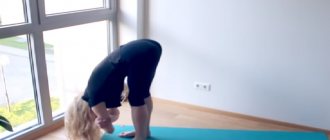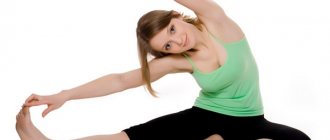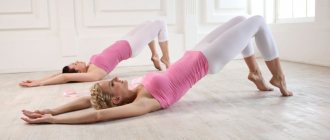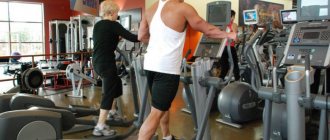Yoga, an ancient practice, has evolved over time but is still relevant today. In the fitness industry in recent years, this is one of the most popular trends.
Power yoga appeared relatively recently, in the late eighties, created by Brian Kest. Many Western trainers worked on its improvement, thanks to which this dynamic practice (a type of Ashtanga yoga) acquired a set of exercises based on synchronized fast movements and controlled breathing. It is characterized by intense training to unify the mind and body, improving speed, endurance and coordination.
For what purpose?
Power yoga is aimed at developing body plasticity and increasing muscle strength. When performing asanas, the emphasis is on breathing. This is a fast pace while maintaining breathing rhythm.
It is accessible to almost everyone. Certain groups of people are especially advised to:
- lovers of strength training, improving their body shape;
- representatives of martial arts who combine their main sport with additional training;
- retired athletes who need to maintain the required level of athletic shape.
Power yoga for beginners involves a series of exercises performed at a set speed. Experts believe that this direction contributes to the formation of a hardy, aesthetic body, develops a person’s internal qualities, and helps to increase physical strength and willpower.
Reference! During classes you need to pay attention to every part of the body. The main load goes to the arms, legs, back and abs. The greatest effect is achieved by accurately performing asanas and holding in one position for about a minute (60-70 seconds).
What is yoga
Yoga is a system of self-improvement that includes meditation, cleansing techniques, mantras, breathing practices and simple exercises, during which a person not only improves the condition of his body, but also engages in self-development. With regular exercise, you can cope with excess weight and establish harmony with yourself. But if you do only physical activity, in isolation from the other components of yoga, then it will be just gymnastics.
For men
Basic exercises have a special effect on the stronger sex. In men, a powerful corset of muscles is formed while maintaining their plasticity. Power yoga is used to pump up muscles, develop ease of movement and flexibility of the body. Today, climbers, athletes, tennis players and speed skaters use this direction in their training.
Dynamic power asanas are suitable for men who focus on increasing endurance and developing sculpted muscles. The direction helps to build muscle mass, while maintaining the elasticity and flexibility of the body, which compares favorably with conventional strength training.
For women
The body of the fair sex reacts somewhat differently to Power yoga classes. First of all, strength exercises and tempo breathing strengthen the muscles. There is no need to worry about excess muscle mass; girls will not develop it. Asanas create an athletic and feminine body. Breathing technique has a specific effect on a woman’s reproductive system and reduces pain during menstruation.
This type of yoga gets rid of extra pounds and is practiced for weight loss and weight stabilization. It also serves as a source of spiritual strength and improves self-control and self-confidence.
How much time should you devote to yoga at home?
As much as possible, but there are people who practice yoga throughout the day. You must decide for yourself how much time you can devote to studying and only then implement your plans. Please note a few things:
- Determine a realistic time during which you can do yoga.
- Do not forget that it is better to practice daily for 15 minutes than once a week for several hours.
- Approach yoga as a pleasant game that does not limit you, but only brings joy.
- It is better to practice shorter asanas at first, and after a few weeks or months you can extend the time. Ideally: 15 minutes, 30 minutes, 45 minutes, 1 hour or 1.5 hours.
Benefits and Benefits
Strength exercises create a strong and beautifully built figure. The result is achieved by gradually increasing the approaches, increasing the load, and regularity of exercises.
The advantages of exercise are obvious:
- the training process is carried out without sports equipment;
- there is no need for strict, grueling diets;
- excess weight disappears, the figure acquires graceful and elegant forms, high plasticity;
- formation of the right attitude towards nutritional benefits.
Reference! Asanas can be performed daily. They do not cause overload and overstrain, strengthen the body, improve tone and mood.
Contraindications
Certain categories of people should not practice power yoga. Exercises are contraindicated for those suffering from mental disorders, neuroinfections and cardiovascular diseases.
There are temporary contraindications. It is not recommended to perform asanas in case of general malaise and physical fatigue, in the period after operations. It is imperative to consult with the trainer and your doctor before starting classes.
- High blood pressure. Caution should be exercised, although blood pressure can be controlled with medications. You should stop training if medications don’t help. It is forbidden to perform any stances; an attack of hypertension can provoke a stroke.
- Injured joints. Athletes with wrist and shoulder injuries should not do handstands. If you have problems with your knees, the lotus pose is contraindicated. Excessive loads injure joints; they must be protected from overexertion.
- Advanced age. Despite the fact that power yoga exercises can be performed at any age, there are certain contraindications and recommendations for older people. When exercising, you need to be careful and pay more attention to your health, balance the load and level of training. Experts advise exercising under the guidance of a professional trainer to avoid injuries and health problems.
Basic complex for beginners
Basic asanas, like no other, are suitable for beginners to practice power yoga. They will help you master the correct breathing and relaxation techniques and serve as the foundation for increasing muscle strength.
Legendary meditation course for free We recommend! The most popular meditation course for beginners in Russian. More than 100 thousand people have already learned to meditate. Try it yourself. Read more.
Power yoga includes approximately 300 basic poses. Experienced trainers recommend that beginners use only a few asanas for each workout. This will allow you to create a rich and effective training program.
Achieving success in yoga is impossible without taking into account the capabilities of your body. For this reason, if you feel unwell or dizzy, stop exercising and modify the exercise.
A complex of several asanas (suitable for men and women):
- Rudrasana (sumo pose) . Among power asanas, one of the most powerful. Exercise develops strength and endurance. It is suitable for training the lower back and back, hips, knees and ankles, and abs.
- “Six points” or plank (Kumbhakasana). The asana strengthens the muscles of the body and develops the ability to maintain balance.
- "Tree" (Vrikshasana). An effective exercise for developing flexibility. A novice yogi, having learned to perform the asana, can balance on one leg and control his own breathing.
- Warrior asana (Virabhadrasana). Increases certain qualities of strength and endurance required for yoga practice. The effect is achieved by stretching and strengthening the gluteal and thigh muscles.
- "Boat" (Navasana). Strengthens the abdominal and back muscles, as well as the arms and shoulder girdle.
- Shalabhasana (locust or grasshopper pose). It is used to tone the lower body and increase physical endurance.
For thighs and buttocks (approximately 6-8 min.)
To reduce the volume of the hips and buttocks, the following poses are best suited:
- Baddhakonasana . This asana is effective only for the thighs. It is called the butterfly pose due to the fact that the position of the legs in this case allows them to imitate the flapping of the wings of this insect. Before exiting it, as you exhale, bend forward as much as possible, pressing your chin to the floor, and as you inhale, rise up.
2. Malasana . Most suitable for people with sedentary work. Having taken a pose, you need to remain motionless for 10 breathing cycles, then sit on the mat, relaxing your legs. The asana helps stretch the hips and groin muscles, toning and improving the flexibility of the hip area.
3. Anjaneyasana . Take a pose while inhaling, then with each subsequent exhalation, gradually lower the pelvis lower and lower, after which remain in the occupied position for 5-6 minutes. During the execution, breathing should remain calm. This asana allows you to stretch the muscles of the legs and thighs, thereby increasing their tone and elasticity, as well as strengthening the hamstrings.
4. Ardhabhekasana. This is one of the most difficult asanas for beginners, but it helps to significantly speed up the achievement of the desired result. In the process of performing it, you need to breathe deeply and evenly only through the chest (inhalation is equal to exhalation), 30-40 seconds are carried out separately for each leg. By stretching and strengthening your hips, quads, and hamstrings, you can tone your leg muscles and stimulate blood flow throughout your body.
5. Garudasana . It is a “twisting” asana that works the hips and all the muscles of the limbs. Performed separately for each leg after several calm breathing cycles. The need to balance while doing it teaches you to find balance and also helps strengthen your heart muscle.
6. Ananda Balasana . Regular yoga practice promotes rapid weight loss, but this asana is considered one of the best ways to achieve this goal, as it can help stretch the entire lower body. In this case, special attention should be paid to the position of the femur, which should be perpendicular to the floor. Having taken this position, you should try to lower your knees to the floor with each subsequent exhalation, while at the same time creating resistance with your hands. Stay in this position for a minute. When performed correctly, it strengthens the inner thighs, groin muscles and hamstrings.
7. Rajakapotasana . The asana not only tones the thigh muscles, but also provides a strong stretch for the legs and spine. During the execution, you should maintain even breathing, remaining in the pose for a comfortable time. The legs alternate.
8. Supta Baddha Konasana . Helps stretch and target the inside of both thighs. The need to balance with your feet connected and your toes pressed in at the same time can help stimulate the hip muscles. You need to breathe evenly, remaining in this position for as long as possible. The asana relaxes well, relieving all accumulated tension from the legs.
9. Upavishtakonasana . More reminiscent of a split, differing only in the need to lean forward. You need to engage it while exhaling, breathing freely. Deep stretching allows you to relieve the muscles of the torso and pelvis from accumulated tension, and also increases the tone of the hips.
For advanced
These several asanas are recommended for experienced practitioners to create a set of exercises:
- "Triangle" (trikonasana). The exercise serves to stretch and strengthen the leg muscles.
- Bhujangasana. Perfectly relieves fatigue, strengthens the spine and buttock muscles.
- Ardha Matsyendrasana. Used to stretch the abdominal muscles, develop the neck muscles and shoulder joints.
- Chaturanga Dandasana. It is performed to strengthen the shoulder girdle and abs, arms and back muscles.
Important! While performing a set of power yoga asanas, you need to maintain a given breathing rate. After completing the exercises, it is recommended to drink water and lie down for general relaxation of the body. Typically, Shavasana (corpse pose) is used for this.
Yoga for weight loss - where to start
Where to start, how to organize the process and what to expect (or not to expect) from losing weight through spiritual practice? Let's look into everything thoroughly.
Losing weight with the power of thought
What is yoga and is it possible to lose weight using a self-improvement system based not so much on the physical, but on the spiritual component? Losing weight in the case of this ancient practice is not a goal, but a result. It’s just that in the process of training, you change your consciousness and yourself in such a way, influence muscle groups in such a way that you ultimately rebuild the work of your body in the right way, teach it not to store fat by gaining weight, but, on the contrary, to get rid of extra pounds.
Or rather, everything that is unnecessary - negative thoughts, depression, excessive love for material things, addiction to heavy food (like meat) - goes away, and positive thinking, cleansing of the mind and body, and long-awaited harmony come.
The Beginner's Path
Where to begin?
Enlightenment and purification
Some advise first to start mastering the spiritual and moral stages, of which there are two – Yama and Niyama. They instill principles of morality, non-violence, self-discipline and other positive qualities.
Others talk about the need to first engage in cleansing techniques, which are called shatkarmas. This helps to cleanse not only the body, but also the mind, and generally contributes to the health of the body.
Still others say that you don’t have to do any of this, but go straight to the point about the first exercises. And everything else will gradually come on its own.
We sing mantras
Gradually learn to read mantras. A mantra is not a prayer or a spell, as the ignorant might think. Yes, they originate in the Vedas - the texts of the Hindu scriptures and consist mainly of the names of deities.
But this is a kind of tool with which the practitioner tries to influence himself, his body, his mind and, as a result, indirectly changes his life.
The most famous mantra, so to speak, the basic one, is aoum or aum, which when pronounced resembles “om”. In Sanskrit, this is one sign symbolizing the divine triad - Brahma, Shiva and Vishnu. In fact, there are many more symbols here, and all because the number 3 is special in both the Hindu and Buddhist traditions.
To pronounce, sit in a comfortable position, close your eyes, relax and try to pronounce sounds, without pauses, in one breath, pausing only to inhale. For beginners, 3-6 repetitions are enough, but in general their number is 108. This helps prepare for meditation - a state of immersion in oneself, finding peace and self-satisfaction.
Meat – to eat or not to eat?
The next step is vegetarianism. True yogis are very scrupulous in this matter, being confident that proper nutrition, avoiding animal foods, is very important.
At the same time, even the most convinced followers of the teaching do not insist on immediately giving up meat. Everyone is simply sure that once you start practicing yoga, you will sooner or later come to the conclusion that eating killed animals and products made from them is bad.
First exercises
Yoga is not gymnastics at all, and the exercises in it are special - asanas. There are a huge number of them. There are static ones, those in which they remain in one position for a long time, aimed at stretching the spine and strengthening the muscles.
And dynamic ones, designed to warm up joints and muscles, accelerate blood circulation. Each asana has proper breathing. For beginners, the main thing to know is the following:
- Asanas are performed from simple to complex. Start with minimal loads, the easiest asana options and a low level of flexibility.
- Asanas should be alternated - here the correct sequence is very important. If you have done an exercise with a forward bend, then you definitely need to perform asanas with a compensating pose, bending forward.
- Discomfort during exercise is minimal. You don't have to do anything to the best of your ability. Don't be a hero. This will protect you from injury.
- Regularity is the basis of success. Let it be for 15 minutes a day, but there must be classes. It is better if it takes about an hour and a half.
- Concentrate on what you are doing. Don’t wander your thoughts into unknown distances. Think about the exercise you are performing, read mantras to yourself, turn off the TV, radio, protect yourself from extraneous noise. There is only you and the yoga practice.
- Don't ignore relaxation exercises. By skipping them, you deprive your body of much-needed relaxation, its joints, ligaments, muscles and internal organs.
Learning to breathe
Pranayama is breathing exercises that help fill the body with the life-giving energy of the Universe - prana. This is a very powerful technique that is directly related to the ability to meditate.
It takes a lot of time to master it, and experienced yogis do not recommend learning it on your own - inept actions can harm your health.
According to reviews, after just a couple of months, those involved note favorable changes, both physical and psychological:
- improves mood and well-being
- the body's endurance and resistance to diseases increases
- posture improves
- muscles are strengthened
- increased flexibility
First steps
So, after the preliminary course, so to speak, the theory of yoga, let’s begin practice. What does it take to practice effectively at home? Nothing at all.
- Hungry stomach. Yes, all classes take place strictly before meals.
- A mat or towel to practice on.
- Comfortable, loose (“breathable”) clothing.
- A ventilated room with a pleasant body temperature.
- Privacy (choose a time when you are alone at home, or tell your family not to disturb you for a while).
- Relaxing music in the background (or recording of lessons).
Which yoga to choose?
Most adherents advise gaining first experience by practicing hatha yoga. It is considered a classical teaching and has virtually no age or health restrictions.
And, first of all, it is designed to restore physical health, develop flexibility, strengthen joints and spine, calm the nervous system, increase immunity and master the principles of proper breathing.
Experts advise starting with the asana complex “Surya Namaskar” - in other words, “Salutations to the Sun”.
It is believed that it is best performed in the morning, at sunrise, facing it. Another option is in the evening, before dinner, since this unique ritual of sun worship promotes good digestion.
Briefly, it looks like this video - you do a sequence of 12 asanas, starting and ending with the “praying pose”.
It is recommended to repeat this complex from 3 to 12 times.
What to remember
So, what have we learned today about how to do yoga for beginners and still lose weight?
- There are no special asanas specifically for weight loss.
- To lose weight with yoga, you just need to start doing it.
- You need to start practicing with the simplest asanas, gradually increasing the load and duration of the session.
- You should feel comfortable performing a particular pose. Avoid heavy loads and you will avoid injury.
- Exercises should be regular, preferably an hour every day, at least 2-3 times a week.
- You shouldn’t force yourself and immediately give up food of animal origin - everything will come gradually with immersion in practice.
- Don't expect quick weight loss with the help of yoga - this path may take a long time, but the lost weight is almost guaranteed to never come back.










